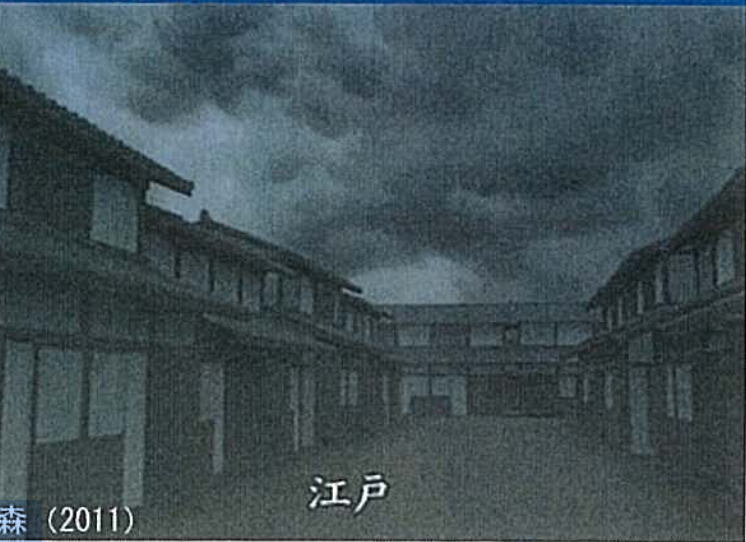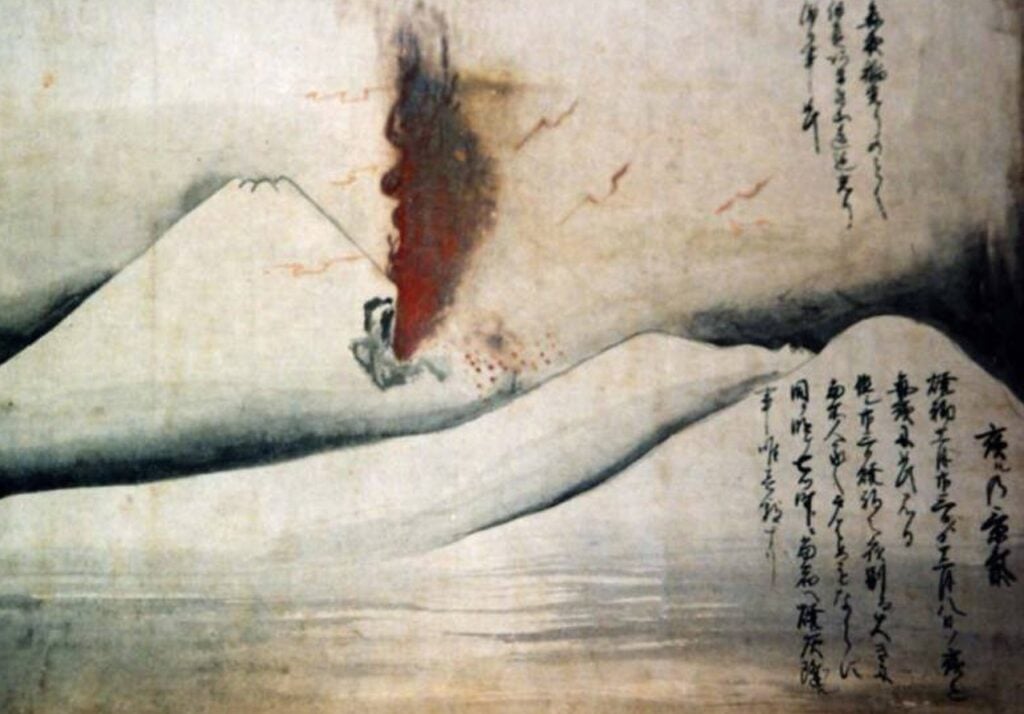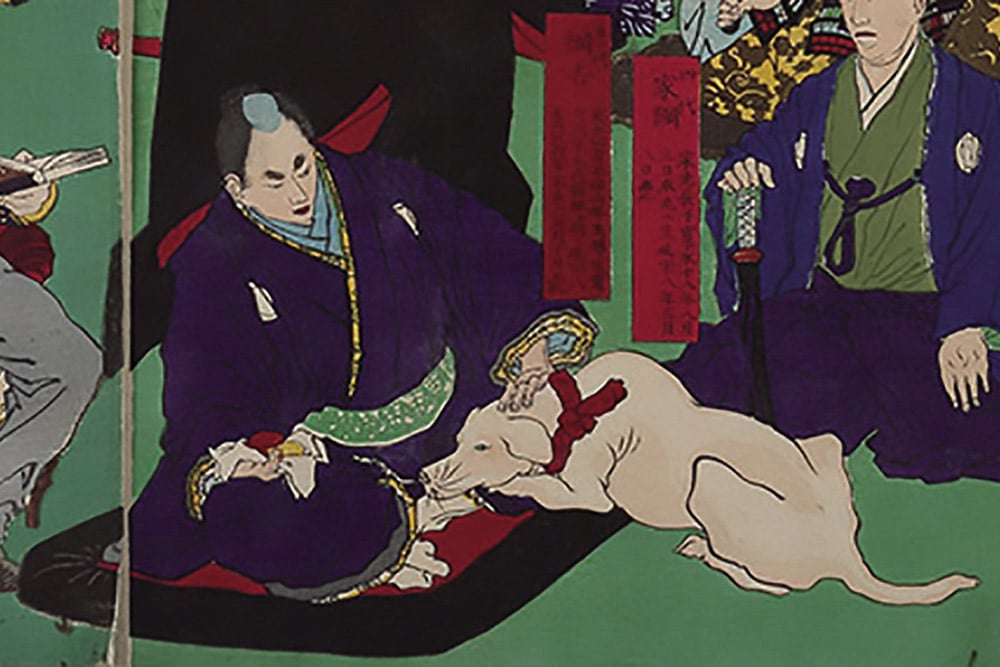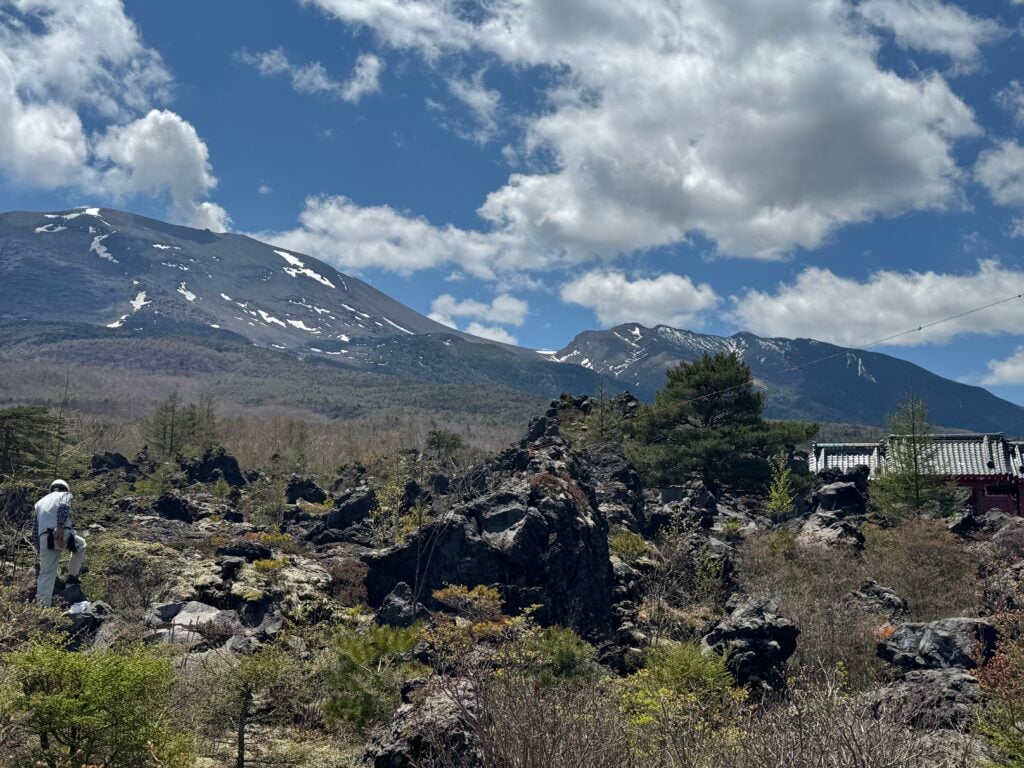On clear days, you can see it from distant Tokyo: Mt. Fuji. At a height of 3776 meters (12,389 ft), Mount Fuji is Japan’s largest and tallest mountain by far, rising dramatically out of the wilds of Shizuoka and Yamanashi prefectures. A focus of mountain worship for eons, it’s one of the great symbols of Japan. A striking mountain when viewed from afar, the hiking paths on the mountain itself are craggy and bare of vegetation, and often shrouded in mist. During the summer climbing season, when 200-300 thousand people ascend the mountain’s flanks, hiking conditions can be so crowded that climbers will be in stop-go traffic. They surmount the switchbacks to the summit single-file, clambering over loose volcanic rock all the way.
The terrain of the mountain is volcanic because, of course, Mt. Fuji is a volcano. And one, it so happens, that’s had numerous violent eruptions throughout its history.
Fuji is famed for its conical appearance; a near-perfect cone shape so iconic that it’s easily recognizable in silhouette. Across Japan, similarly cone-shaped mountains, all much smaller, are given regional names after the true Fuji: Mt. Yotei in Hokkaido is “Ezo Fuji”; Fukushima locals call Mt. Bandai “Aizu Fuji”; and many more. And yet, since the last time Fuji erupted, the mountain no longer posesses its once truly conical shape. That’s because the eruption was so powerful that it remade Mt. Fuji’s very shape, leaving a deep recessed gorge some 400 meters (1312 ft) deep, forever scarring the mountain.
Mt. Fuji: Clear and Present Danger?
Surrounded by the towns and cities of Yamanashi and Shizuoka prefectures, and with Tokyo, the world’s most populated urban area, only 95 km (60 miles) to the southwest, Fuji’s volcanic nature still presents potential danger. And yet, the last time Fuji erupted isn’t a topic of frequent conversation, despite the disaster it wrought. The eruption came at a point in history that’s both distant from living memory, but not so ancient as to exist in the far distant past. Fuji sits at the boundary between two major faults in one of the world’s most seismically active countries; another eruption is a question of when, not if (although that when may still be in the distant future).
So, let’s journey to recent samurai past to discover the last time Mt. Fuji erupted… and what lessons we might take for the next time the mountain roars to life.
 The massive craters from Fuji’s last eruption. The protruding mass to the large crater’s south is Mount Hoei.
The massive craters from Fuji’s last eruption. The protruding mass to the large crater’s south is Mount Hoei.
Hot and Cold: The History of Mt. Fuji Eruptions
The most recent eruption of Mt. Fuji was far from the only notable time the mountain blew its top, although the earliest documented case only comes in AD 781. Long before that, prehistoric eruptions of three nearby volcanoes resulting in sediment build-up; this build up eventually became the massive, conical Mt. Fuji we know today. In ancient times, Fuji erupted often enough that the 8th century poetry collection the Manyoshu speaks of “…the ‘burning fires’ of Fuji and calls it a ‘god mysterious.’” [3]
The most notable previous eruption during the last 2000 years came in AD 864, during the Heian era, when the emperor ruled from Kyoto and poetry and art flourished.
The Jogan Eruption
This was the Jogan eruption, when the summit of Fuji blew expelled an incredible amount of fiery ash, and huge quantities of lava streamed down Fuji’s west flank, pouring into the then-immense Lake Senoumi. The lava flows filled in vast areas of the lake and then hardened, splitting the body of water in two. These became Lakes Saiko and Shojiko, 2/5ths of the famed Fuji Five Lakes. The lava field is now covered by the dense, eerily quiet treescape of Aokigahara Forest. This so-called “Sea of Trees,” which has a dark reputation internationally as a destination for those who wish to end their lives, was only a few centuries old when samurai armies passed it by during the Heikei War (1180–1185).
The Heian era was a particularly active time for Mt. Fuji. Twelve eruptions occurred between the years 800 and 1083. Centuries then passed with Fuji entering a state of calm; after 400 years, Fuji produced some minor eruptions in 1511 and 1560. The danger the volcano posed could be easily forgotten, with nearly a thousand years passing from the last massive eruption in 864.
Then came the winter of 1707. For generations, the fierce power of Mt. Fuji would be well remembered.
 The three volcanoes that would eventually converge into Mt. Fuji some 100,000 years ago.
The three volcanoes that would eventually converge into Mt. Fuji some 100,000 years ago.
The Great Mt. Fuji Eruption of 1707
It began on the wintry morning of December 16th, 1707. There had been ominous signs; a month before, a massive 8.7 earthquake to the west in Wakayama shook the villages near Fuji. From then on, tremors continued around the mountain, growing in intensity. And yet, the population around Mt. Fuji, mostly farmers, religious mountain guides (oshi, 御師), and workers at the post towns on the road between the samurai capital of Edo and Kyoto to the far west, had little reason to worry about the mountain. They’d lived next to Fuji for generations, with none having seen the Fuji emit even a little smoke.
The day before, December 15th, brought another large quake. As the morning of the 16th dawned, a great rumbling was heard from the mountain; a local oshi recorded that people feared the Fuji was about to tear asunder. [1] Their fears were partially founded. Around 10 AM, white smoke was seen emerging from Fuji’s southeast flank. The amount of smoke increased rapidly; soon, steaming hot volcanic ejecta began to rain upon nearby villages, lighting houses on fire and burying fields. As the sky darkened, a pillar of fire appeared within the billowing smoke. Reports also speak of a volcanic thunderstorm, with lightning rippling through the ash.
The eruption burst through the southeast flank of Fuji, forming three new vents. The area around the vents collapsed into deep craters; volcanic material piled up on the largest crater’s side, forming a new secondary peak on the mountain. The Hoei Eruption had begun.
Terror in the Samurai Capital
60 miles away, the samurai capital of Edo (modern Tokyo) began experiencing strange phenomena. From around 10 AM, the shoji sliding doors of the capital began to rattle without wind or shaking ground. A monk and counselor to the Shogun, Ryuko, was at the castle for a ceremony as the assembled lords took note of the strange sight. He wrote of the occurrence in his diary. The denizens of Edo, many of whom noted the rattling of doors and windows, could not have known that the cause was the massive shockwave from the eruption at Mt. Fuji, 100 kilometers distant.
Not long after, the ground began to shake. The sky over the capital steadily darkened, as though night had fallen at midday. As scholar Bodart-Bailey notes, “by three o’clock in the afternoon it was raining white ashes, covering the city like snow.”
Planning a trip to Japan? Get an authentic, interpreted experience from Unseen Japan Tours and see a side of the country others miss!

“Noah [at Unseen Japan] put together an itinerary that didn’t lock us in and we could travel at our own pace. In Tokyo, he guided us personally on a walking tour. Overall, he made our Japan trip an experience not to forget.” – Kate and Simon S., Australia

See a side of Tokyo that other tourists can’t. Book a tour with Unseen Japan Tours – we’ll tailor your trip to your interests and guide you through experiences usually closed off to non-Japanese speakers.


Want more news and views from Japan? Donate $5/month ($60 one-time donation) to the Unseen Japan Journalism Fund to join Unseen Japan Insider. You’ll get our Insider newsletter with more news and deep dives, a chance to get your burning Japan questions answered, and a voice in our future editorial direction.
Damage was seen as far afield as the villages located in modern-day Yokohama. There, tephra (volcanic ejecta) clogged irrigation and resulted in flooding. [1] In Edo, people complained of respiratory problems – the result of inhalation of fine ash. [4] Soon, exhausted messengers from Fuji appeared at the gates of Edo Castle, and the Shogun’s government knew a crisis was at hand.
 Artist’s rendering of the darkened state of Edo during the eruption. Source: Mt. Fuji Jukū Forest Park.
Artist’s rendering of the darkened state of Edo during the eruption. Source: Mt. Fuji Jukū Forest Park.
The Dog Shogun: Tokugawa Tsunayoshi
It’s a quirk of historical timing that this particular disaster would occur during the reign of the 5th Tokugawa Shogun, Tsunayoshi. The most controversial and denigrated of all samurai rulers of Japan, Tsunayoshi stands out most for his extreme benevolence. The fourth son of Tokugawa Iemitsu, the iron-fisted third shogun of the dynasty, Tsunayoshi was never intended to rule. His father noted his intelligence from a young age, deciding he should be raised as a scholar rather than as a warrior. (Iemitsu believed this would prevent Tsunayoshi from usurping power from his older brothers.) Tsunayoshi’s elder brother, Ietsuna, ruled as shogun for three decades but died without an heir in 1680. Tsunayoshi unexpectedly found himself the military dictator of all Japan.
Tsunayoshi’s outlook on the role of the samurai as stewards of Japan differed greatly from that of any shogun before or after. His brother and ancestors had been warlords who believed in the right of might; benevolence for the commonfolk was only so necessary as it could help avoid dangerous uprisings. But Tsunayoshi, not raised as a warrior, believed that the samurai government should protect all those over whom it ruled. He promulgated the so-called “Laws of Compassion,” shogunal edicts that protected the poor, sick, and abandoned children. Most famous (or infamous), however, were his laws outlawing animal cruelty. These began with those protecting horses, but it’s the edicts criminalizing the poor treatment of dogs that earned Tsunayoshi the sobriquet he still bears today: Inu Kobo, “Dog Shogun.” [2]
By happenstance, the massive Hoei Eruption occurred in the last years of Tsunayoshi’s reign. This still would have been an important event during any shogun’s reign, but only the”Dog Shogun” would have paid the same attention to the suffering of those affected.
 Shogun Tokugawa Tsunayoshi (1649-1709).
Shogun Tokugawa Tsunayoshi (1649-1709).
The Shogunate Bolts into Action
The Hoei Eruption of Mt. Fuji occurred nearly three decades into Tsunayoshi’s rule. This was a unique time during the 700 years of samurai rule in Japan; it was perhaps the only time when the common people who represented the majority of the archipelago’s population would feel they could truly turn to their samurai overlords for assistance. Tsunayoshi’s edicts regarding the need for benevolence were well known; the common folk most affected by the mass destruction wrought by Mt. Fuji knew they could pressure local samurai into action by threatening to head to Edo en masse. Samurai lords, whether inclined towards compassion or not, knew the Shogun’s thoughts on such matters – and the harsh punishments he sometimes meted out to those his government accused of cruelty. [1]
The villagers in the path of Fuji’s wrath had good reason to turn to the shogunate for assistance. Entire villages had been wiped off the map, buried under meters and meters of pyroclastic missiles or burnt to nothingness by fiery volcanic fallout. Masses of ash were building up on the flanks of Mount Fuji, and as heavy rain came in, ash mixed with water into deadly lahars; flows of muddy water and ash that washed down into the valleys below. The lahars rushed downwards, destroying already damaged villages and damming up rivers and polluting fields. Surviving villagers, many now homeless, faced starvation as ash, mud, and smoldering rocks piled over their rice fields.
 A contemporary painting shows a night view of Mt. Fuji erupting in 1707.
A contemporary painting shows a night view of Mt. Fuji erupting in 1707.
Peasants Threaten Uprising
With typhra piling more than 20 feet high at the base of Mt. Fuji, a mass of affected villagers from Odawara Domain began making their way to the samurai capital. The villagers were enraged, having received only vague platitudes from their liege lord Ôkubo Tadamasu, issued from his mansion in Edo. Approximately 60% of Odawara Domain was covered in ash; yet Lord Ôkubo, safe in faraway Edo, was more incensed by the actions of these peasants. He suggested the ungrateful villagers be thrown in jail – that is, until he went to Edo Castle, likely to speak with the Shogun. When he returned from his visit, his attitude had changed completely. Now he promised to assist his villagers in any way possible, even offering to sell his prized family sword to raise funds.
Irrespective of Lord Ôkubo’s sudden pangs of conscience, by March, the Shogunate had decided that the local lords of the Fuji area were not up to the task of saving the commoners. The lands were temporarily removed from control by their local lords and instead directly administered by the central government; an unprecedented move at the time. Under magistrate Ina Tadanobu, a close adviser to the shogun, major efforts were made to clean up farmland, house commoners, and provide both financial and food relief. The damage from the eruption was so vast, however, that even the Shogunate’s coffers weren’t deep enough for the effort. Instead, a country-wide tax was announced, with payment to be made based on the size of one’s residence. With this mostly affecting powerful samurai, a simmering anger began to develop towards the shogun amongst Japan’s warrior elite. [1]
Farewell, Dog Shogun
The new craters on Mt. Fuji’s southeast flank finally ceased erupting on January 1st, 1708. They had continued to emit smoke and projectiles for 16 days, making recovery efforts extremely difficult; as hundreds of laborers worked to clear villages, farmland, and overflowing rivers, the mountain deposited new ejecta, making their efforts feel worthless. Lahars would continue to plague the area for another century.
And yet, the edicts of the central Shogunate had saved countless villagers from starvation, and helped position vast tracks of countryside for recovery after the disaster. No peasant riots had occurred, and samurai officials from both local domains and the Shogunate worked hand in hand to restore the land, even as new floods and other knock-on disasters occurred. Progress was being made.
And then, almost exactly one year after Mt. Fuji ceased belching smoke, Shogun Tokugawa Tsunayoshi died. He was quickly replaced by his nephew, Ienobu; before Tsunayoshi’s cremation, Ienobu insisted that various important lords bow before the former shogun’s body and beg his forgiveness for what they were about to do: repealing his “Laws of Compassion.” Shortly thereafter, direct shogunal assistance to the areas stricken by the Fuji disaster ceased. The era of samurai benevolence had ended.
 Tokugawa Tsunayoshi with a beloved dog. From “Tokugawa Reidai Zouken,” by Tsukioka Yoshitoshi. 1875.
Tokugawa Tsunayoshi with a beloved dog. From “Tokugawa Reidai Zouken,” by Tsukioka Yoshitoshi. 1875.
After Effects
A legend lives on in the affected regions of Suruga Province regarding magistrate Ina Tadanobu, charged with managing the eruption cleanup. He died suddenly, not long after the shogun; the tale goes that, with funds no longer available to help those affected, Tadanobu made the unauthorized action of distributing large quantities of rice from the Shogunal holdings in nearby Sunpu Castle to starving villagers. He then committed seppuku to atone for this crime of compassion. A shrine to Tadanobu was erected well over a century later, in the dying days of the Tokugawa Shogunate. As Bodart-Bailey notes, this late-stage tribute “…may be an indication that Tadanobu had fallen out of grace with the regime, a government that after the death of the fifth shogun no longer considered the farmers ‘the foundation of the state’ to be governed ‘so that they do not suffer from hunger cold …’”
Tokugawa Tsunayoshi’s policy of benevolence during natural disasters was thrown into stark contrast by a major eruption some eighty years later. In 1783, Mt. Asama, to the northwest of modern Tokyo in Nagano Prefecture, violently erupted, killing some 1624 people in the surrounding area. While the Shogunate under Tokugawa Ieharu did offer some assistance, it was not on the same scale as his predecessor. Nor were the worries of starving peasants first on his mind. The eruption was a major contributor to the horrible Tenmei Famine, the worst in the early modern period. Shogunate economic policies greatly exacerbated the famine. Unlike in Tsunayoshi’s time, peasant grievances were not respected, and mass riots and protests resulted. [1]
 A field of large magma deposits from the Mount Asama eruption of 1783. Gunma Prefecture. Photograph by author.
A field of large magma deposits from the Mount Asama eruption of 1783. Gunma Prefecture. Photograph by author.
What Could Happen Next with Mt. Fuji?
Since Mt. Fuji quieted in early 1708, the mountain has never again awoken. Memories of the destruction and of ashy snows in old Edo have long since been forgotten; the event is essentially absent from Japanese textbooks. For over three hundred years, Fuji has slumbered. And yet, the idea of Mt. Fuji roaring back to life is not an infrequent subject of conversation, speculation, and governmental preparation. Fuji is technically “dormant,” but as Japanese researchers have stated, the volcano is only “superficially inactive.” [4]
Planning a trip to Japan? Get an authentic, interpreted experience from Unseen Japan Tours and see a side of the country others miss!

“Noah [at Unseen Japan] put together an itinerary that didn’t lock us in and we could travel at our own pace. In Tokyo, he guided us personally on a walking tour. Overall, he made our Japan trip an experience not to forget.” – Kate and Simon S., Australia

See a side of Tokyo that other tourists can’t. Book a tour with Unseen Japan Tours – we’ll tailor your trip to your interests and guide you through experiences usually closed off to non-Japanese speakers.


Want more news and views from Japan? Donate $5/month ($60 one-time donation) to the Unseen Japan Journalism Fund to join Unseen Japan Insider. You’ll get our Insider newsletter with more news and deep dives, a chance to get your burning Japan questions answered, and a voice in our future editorial direction.
The 2011 Great East Japan Earthquake directly focused public attention on Fuji’s volcanism. That devastating magnitude 9.0 megaquake triggered a 5.9 magnitude quake beneath Fuji’s southern flank, directly above the volcano’s magma system. This led to the Japanese government proclaiming the Proposal for Large-scale Volcano Disaster Countermeasures. [4]
What exactly would a modern Mt. Fuji eruption look like? The Hoei Eruption of 1707 gives us a window into the possibilities. And yet, it’s not a perfect guideline, since Fuji has numerous types of eruptions in its long history. At times, eruptions exploded upwards from Fuji’s summit in a Plinian eruption. Other times, Fuji belched streams of lava, and in 1707, it experienced a flank eruption. Exactly which region around Fuji could next be in danger is hard to say.
Twin Dangers: Collapse and Ash
Two main crises could be caused by Fuji again erupting: a major sector collapse, and the blanketing of Tokyo in volcanic ash. The former would mean an entire section of Mt. Fuji being shaken loose by an earthquake or eruption, resulting in a devastating landslide that could spread out for miles. This would be similar to the 1888 explosion of Fukushima’s Mt. Bandai, the worst volcanic disaster in modern Japanese history. Fuji’s western slope is “gravitationally unstable”; i.e., it slopes at a 34-degree angle, steeper than most pyroclastically formed mountains. A major eruption could shake part of the slope loose, sending it tumbling towards the closest communities – which lie 12 km from the summit, within potential striking range. [4]
For the great population centers in sight of the mountain, however, it’s ashfall that would pose the most likely danger. Ash blanketed the streets of Edo during the Hoei Eruption; in the modern day, ashfall has additional ramifications that weren’t present in the samurai era. In terms of physical danger, the Tokyo government worries that ash buildup, combined with rain, could create burdens on wooden buildings in Tokyo heavy enough to cause collapse. The Tokyo government has a 4-stage ashfall response plan ready for such an event; if more than 30 cm (1 foot) of ash falls on Tokyo, the prefecture is prepared to begin evacuations of its many millions of residents. [5]
(Notably, the Hoei Eruption only dusted old Edo with around 4 cm of ash. 30 cm would mean this was a far greater eruption than that of 1707.)
Disruption of Power
Even smaller amounts of ashfall can still result in railway and plane stoppage, and worse, could damage Tokyo’s vast electrical grid. TEPCO supplies Tokyo with 50 GW of energy every day. Much of Tokyo’s electricity comes from thermal generators located near Tokyo Bay. These are within the range of the ashfall from Fuji’s last eruption, and could easily be disrupted by ash clogging gas turbines. Massive power outages could result, disrupting life here in the Japanese capital and beyond. And backup electricity from western Japan power plants traverse lines near Mt. Fuji; in other words, locations that could be destroyed by volcanic missiles. [4]
Fuji Still Slumbers
All in all, experts expect that the next eruption of Mt. Fuji could disrupt Japan to the tune of around $16 billion. The potential impact on those living near Mt. Fuji or climbing the mountain at the moment of explosion would be deadly indeed. Mass power outages for the 37 million who live in the Tokyo metro area could also create life-threatening issues. Supply chains could well collapse.
Still, there’s little reason to fret or avoid the Fuji region for fear of cataclysm. Mt. Fuji has been dormant for centuries, and our understanding of seismic and volcanic activity is improving all the time. There would likely be signs before an eruption, and even if Fuji were to erupt again, it may still be centuries in our future.
Perhaps most heartening is the lesson of Shogun Tokugawa Tsunayoshi. In his time, his compassion was the true exception to seven hundred years of military rule. His government helped victims of the Hoei disaster in a way that was then unprecedented. In our modern culture, government and civilian aid are the rule, rather than the exception. Bureaucratic bumbling notwithstanding, we no longer have to rely on a single benevolent ruler chancing to inherit the throne. When the next Mt Fuji eruption comes, we can hope to be a little more ready.
 Mt. Fuji soars above Kamakura and Hakone. Photograph by author.
Mt. Fuji soars above Kamakura and Hakone. Photograph by author.
Sources:
[1] Bodart-Bailey, Beatrice M. (2015). Pyroclastic rivers: The Hôei Fuji Eruption (1707). In Local Realities and Environmental Changes in the History of East Asia. Routledge.
[2] Bailey, B. B. (1985). The Laws of Compassion. Monumenta Nipponica, 40(2), 163–189.
[3] Earhart, H. B. (1989). Mount Fuji and Shugendo. Japanese Journal of Religious Studies, 16(2/3), 205–226.
[4] Yamamoto, T., & Nakada, S. (2015). Extreme Volcanic Risks 2: Mount Fuji. In Volcanic Hazards, Risks and Disasters (pp. 355-376). Elsevier.
[5] (March 21, 2025.) 4-stage ashfall response plan compiled to prepare for Mt. Fuji eruption. The Mainichi.
[6] Naomichi Miyaji, Ayumi Kan’no, Tatsuo Kanamaru, Kazutaka Mannen. (2011). High-resolution reconstruction of the Hoei eruption (AD 1707) of Fuji volcano, Japan. Journal of Volcanology and Geothermal Research, Volume 207, Issues 3–4. Pages 113-129.


AloJapan.com